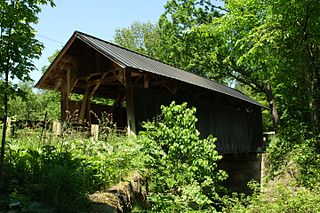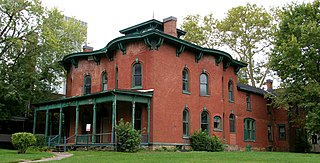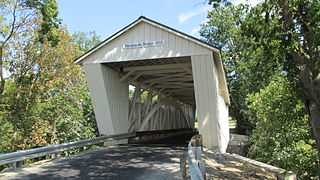
The U.S. Grant Bridge is the name of the two bridges that carry and have carried traffic on U.S. Route 23 between Portsmouth, Ohio and South Portsmouth, Kentucky across the Ohio River in the United States. The original suspension bridge was closed and demolished in 2001 and the replacement cable-stayed bridge opened on October 16, 2006.

The Cornish–Windsor Covered Bridge is a 156-year-old, two-span, timber Town lattice-truss, interstate, covered bridge that crosses the Connecticut River between Cornish, New Hampshire, and Windsor, Vermont. Until 2008, when the Smolen–Gulf Bridge opened in Ohio, it had been the longest covered bridge in the United States.

Old Blenheim Bridge was a wooden covered bridge that spanned Schoharie Creek in North Blenheim, New York, United States. With an open span of 210 feet (64 m), it had the second longest span of any surviving single-span covered bridge in the world. The 1862 Bridgeport Covered Bridge in Nevada County, California, currently undergoing repairs due to 1986 flooding is longer overall at 233 feet (71 m) but is argued to have a 208 feet (63 m) clear span. The bridge, opened in 1855, was also one of the oldest of its type in the United States. It was destroyed by flooding resulting from Tropical Storm Irene in 2011. Rebuilding of the bridge commenced in 2017 and was completed in 2018.

The Cogan House Covered Bridge is a Burr arch truss covered bridge over Larrys Creek in Cogan House Township, Lycoming County, in the U.S. state of Pennsylvania. It was built in 1877 and is 94 feet 2 inches (28.7 m) long. The bridge was placed on the National Register of Historic Places in 1980, and had a major restoration in 1998. The Cogan House bridge is named for the township and village of Cogan House, and is also known by at least four other names: Buckhorn, Larrys Creek, Day's, and Plankenhorn.

The Lynchburg Covered Bridge is a historic wooden covered bridge that spans the east fork of the Little Miami River in Lynchburg, Ohio. It, also, has the distinction, following a recent repair and restoration project, of being the only such covered bridge in North America to have been converted to a pseudo-suspension infrastructure. The bridge was built in 1870 as a Long truss.

The Union Covered Bridge State Historic Site is a Missouri State Historic Site in Monroe County, Missouri. The covered bridge is a Burr-arch truss structure built in 1871 over the Elk Fork of the Salt River. It was almost lost to neglect in the 1960s, but was added to the state park system in 1967, the same year it was damaged by a flood. Repairs were made the next year, using timbers salvaged from another covered bridge that had been destroyed by the same flood. In 1970, it was closed to vehicular traffic and was added to the National Register of Historic Places. Further repairs were made in 1988, and it survived the Great Flood of 1993, only to be damaged by another flood in 2008 and later re-repaired. It is about 120 feet (37 m) or 125 feet (38 m) long, 12 feet (3.7 m) high, and 17.5 feet (5.3 m) wide.

The McColly Covered Bridge is a historic wooden covered bridge in western Logan County, Ohio, United States. Located in Washington Township near the community of Bloom Center, it is one of two remaining covered bridges in Logan County. It carries County Road 13 over the Great Miami River, approximately 5 miles (8.0 km) south of its source at Indian Lake.

The Clinton Falls Bridge, also known as the Old Mill Bridge and formally as Bridge L-5573, is a historic steel Pratt through truss bridge that spans the Straight River in Clinton Falls Township, Minnesota. It was listed on the National Register of Historic Places in 1997 as Bridge No. L-5573 for having local significance in the theme of engineering. It was nominated for being an example of early steel truss bridge design in Minnesota.

Berkeley Springs station is a historic railway depot located at Berkeley Springs, Morgan County, West Virginia. The depot is a one-story, rectangular red brick building with a bell-cast, red tile roof and measures approximately 80 feet long by 20 feet wide. It features Mission Revival style details.

The Seguin Covered Bridge, also called the Upper Covered Bridge and the Sequin Covered Bridge, is a wooden covered bridge that crosses Lewis Creek in Charlotte, Vermont on Roscoe Road. It was built about 1850, and is a distinctive variant of a Burr arch design. It was listed on the National Register of Historic Places in 1974.

Cozad–Bates House, also known as the Cozad–Bates House Interpretive Center, is the oldest and only surviving pre-Civil War structure in University Circle, Cleveland, Ohio, located at the Mayfield Road and East 115th Street intersection. It is historically known for its involvement in the Underground Railroad. Abolitionist Andrew Cozad built the house in 1853 for his son Justus L. Cozad, who in 1872 added an Italianate front to the structure. Architecturally, it is a rare surviving example of Italianate-influenced residential architecture in America at that time, which includes a hipped roof, curved bay windows, paired eave brackets, and prominent belvedere. The house was listed on the National Register of Historic Places in 1974 and designated as a Cleveland Landmark in 2006.

Everett S. Sherman (1831-1897) was a covered bridge builder in Ohio. He lived and built bridges in Delaware County then moved to Preble County after a storm destroyed many of its bridges.

The Stonelick Covered Bridge is located on Stonelick-Williams Corner Road in Clermont County, Ohio, crossing the Stonelick Creek. The one-lane covered bridge was built in 1878. It is 140 feet long and supported using a 12-panel Howe truss. The property was added to the National Register on September 10, 1974, being the last surviving covered bridge in Clermont County.

The Warnke Covered Bridge, also known as Warnke Bridge, is a historic covered bridge crossing Swamp Creek in Harrison Township, Preble County, Ohio, northeast of Lewisburg. Built from 1895 to 1896 by Everett S. Sherman, it has a span of 51 feet. It was listed on the National Register of Historic Places in 1976.

The Christman Covered Bridge is a historic covered bridge that carries Eaton-New Hope Road over Seven Mile Creek in Washington Township, Preble County, Ohio, United States, northwest of the city of Eaton. It was built in 1895 by Everett S. Sherman, who built at least 20 covered bridges in Preble County. It was listed on the National Register of Historic Places in 1976.

The Harshaville Covered Bridge is a historic covered bridge spanning the Cherry Fork Creek at Harshaville, Adams County, Ohio. Built in 1855, it is a Burr truss bridge with a 110-foot span. It has sheet metal siding, a metal roof and stone abutments. It was listed on the National Register of Historic Places in 1976.

The Delhi Bridge, also known as the East Delhi Bridge, is a one-lane, wrought iron Pratt through truss bridge that carries East Delhi Road over the Huron River in Washtenaw County, Michigan. The bridge was completed October 12, 1883 to replace a wooden span built in 1851. In 1917, the bridge was severely damaged by a tornado but was rebuilt. After it was closed to traffic in 2005 for being unsafe, the bridge was renovated and reopened in 2009. The bridge is listed on the National Register of Historic Places.

The Waterloo Covered Bridge carries Newmarket Road over the Warner River near the Waterloo Falls in Warner, New Hampshire. The Town lattice truss bridge was built in 1859-60, replacing an earlier span at the same location, and is one of New Hampshire's few surviving 19th-century covered bridges. The bridge was listed on the National Register of Historic Places in 1976, and included in the Waterloo Historic District in 2003.

The Lincoln Covered Bridge is a historic covered bridge, just south of U.S. Route 4 in West Woodstock, Vermont. Built in 1877, it is one of the only known examples of a wooden Pratt truss bridge in the United States. It was listed on the National Register of Historic Places in 1973.

The Otway Covered Bridge, in Scioto County, Ohio north of Ohio State Route 348 in Otway, was built in 1874 by the Smith Bridge Co. of Toledo, Ohio. It was listed on the National Register of Historic Places in 1974.






















